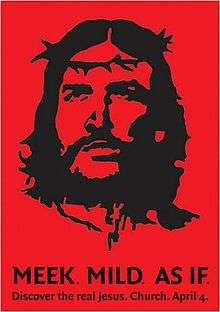Che Jesus

Che Jesus is an image depicting Jesus Christ in the style of Jim Fitzpatrick's iconic two-tone portrait of Che Guevara (itself based upon Alberto Korda's iconic Guerrillero Heroico photo).
Background
The controversial image was created by Chas Bayfield and Trevor Webb for the Churches Advertising Network (CAN) in the UK who used it to encourage church attendance for Easter 1999. The poster used the slogan: 'Meek. Mild. As If. Discover the real Jesus. Church. April 4.'[1][2] 50,000 leaflets were distributed to churches across the UK and posters were put up at bus shelters, train stations and hoardings.[3]
The launch of the Che Jesus image became international news[4] and it later appeared in the 2000 exhibition, Seeing Salvation in London's National Gallery, featured in the Faith Zone in the Millennium Dome and appeared in the 2006 Che Guevara: Revolutionary and Icon exhibition at the V&A Museum.
Controversy
The image outraged conservative church members and some politicians who condemned the marketing strategy as blasphemous for using a violent Communist and atheist to promote Jesus.[5]
Tory MP Ann Widdecombe, who converted from the Church of England to Roman Catholicism some years previously, said: "We should be modelling ourselves on Christ, not modelling Christ on us."[2]
Former Tory MP Harry Greenway, sponsor of the Conservative Christian Fellowship, described the poster as "grossly sacrilegious" and said those responsible for it should be excommunicated.[6] He threatened to protest to the Archbishop of Canterbury, Dr George Carey, in the "strongest possible language".[7]
However, the Bishop of Ely, the Right Reverend Stephen Sykes, defended the campaign and rejected accusations that it was blasphemous. "The intention of the advertisement is to cause remark," he said. "It has been successful."[3] He added:"While an analogy is implicitly drawn between the revolution of a political leader and that of Jesus, it is not said or implied that Jesus was a political revolutionary or would have endorsed the actions of Che Guevara."[8][9]
The Reverend Tom Ambrose, a member of CAN and Director of Communications for the Diocese of Ely, said the poster was designed to make people think about Christianity. "We want people to realise that Jesus is not a wimp in a white nightie or someone who is a bit of a walkover, but a strong, revolutionary figure."[2]
The Washington Post joined in the debate dismissing the campaign as "symptomatic of a silliness that respects no borders".[10]
The artwork for the poster was created by photocopying a painting of Christ on to acetate and laying this over a copy of Korda's photo. By tracing over the two faces, a composite face was created. This was then traced again and inked in to create a black and white copy. This was scanned in to an Apple Mac, the background changed to red and the type added by Matt McMullen.
References
- ↑ God help those who confuse advertising and PR disasters. Marketing Week. 14 January 1999.
- 1 2 3 Jesus sheds 'wimpish' persona in a revolutionary makeover. The Guardian. 6 January 1999
- 1 2 BBC News website. 7 January 1999
- ↑ Peter McLaren (1999). Che Guevara, Paulo Freire, and the Pedagogy of Revolution. Rowman & Littlefield ISBN 978-0847695331. p. 11.
- ↑ Church Ads Send Revolutionary Message. Los Angeles Times. 7 January 1999.
- ↑ Revolution in Church's Easter campaign. The Herald Scotland. 6 January 1999
- ↑ Chesus Christ - MPs slam church poster lookalike of communist firebrand Guevara. Daily Mirror 6 January 1999
- ↑ The Bishop's letter. Ely Ensign. February 1999
- ↑ Bishop backs church ad campaign. Cambridge Evening News. 9 January 1999.
- ↑ Jesus as Che. Will, George F. Washington Post. 14 February 1999